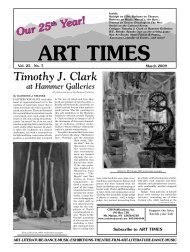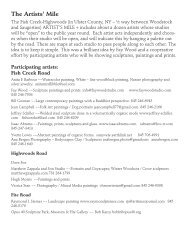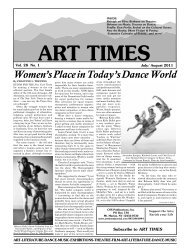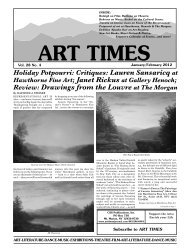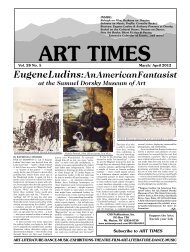September/ October 2012 - Art Times
September/ October 2012 - Art Times
September/ October 2012 - Art Times
You also want an ePaper? Increase the reach of your titles
YUMPU automatically turns print PDFs into web optimized ePapers that Google loves.
Music<br />
By FRANK BEHRENS<br />
Some time ago, I considered how<br />
a director might handle the first<br />
meeting of Don Jose and Carmen.<br />
Now I would like to do the same with<br />
the first meeting of Rodolfo and Mimi<br />
in Act I of Puccini’s “La Boheme.”<br />
Those familiar with the opera’s<br />
source, Henri Murger’s “Scenes de la<br />
vie boheme,” know it to be a series of<br />
short stories, through which several<br />
main characters appear again and<br />
again as in a chemical reaction as<br />
they affect and are affected by one<br />
another. At least six of them were to<br />
appear in Puccini’s treatment of the<br />
tragic love between two of them.<br />
In Murger, Mimi is no angel. Driven<br />
by the necessities of a life on the<br />
edge of starvation and the winter’s<br />
cold, she turns, as so many others like<br />
her, to the streets, always hoping to<br />
find a rich baron or banker who can<br />
show her the high life, even for a little<br />
while. Puccini’s librettists tried very<br />
hard to show her as the good girl with<br />
a heart of gold in contrast to Musetta,<br />
the whore with the heart of gold.<br />
In the past, I have concentrated on<br />
the music of Mimi’s autobiographical<br />
aria, “Mi chiamano Mimi” and took<br />
the words at face value. Poor darling,<br />
who does her best to scrape out the<br />
meanest existence in a pathetic way<br />
but who loves what bits of nature she<br />
can capture in her wretched apartment.<br />
A SMALL SAMPLING<br />
SEPTEMBER LANDSCAPE WORKSHOP<br />
w/ Kate McGloughlin, <strong>September</strong> 10-12<br />
EXPLORING ABSTRACTION WORKSHOP<br />
w/Jenny Nelson, <strong>September</strong> 15-16<br />
PAINTING PLEIN AIR WORKSHOP<br />
w/ Kevin Beers, <strong>October</strong> 3-5<br />
FALL FOLIAGE IN<br />
WATERCOLOR WORKSHOP<br />
w/ Staats Fasoldt, <strong>October</strong> 10-12<br />
When Mimi Meets Rodolfo:<br />
a Challenge to Directors<br />
Just earlier, her candle blows out<br />
in the hallway outside the garret<br />
apartment of Rodolfo, Marcello, Colline,<br />
and Schaunard. (The last three<br />
are waiting for their poetic friend<br />
downstairs with, it would seem, a<br />
large degree of patience.) She timidly<br />
knocks on the door, Rodolfo opens it,<br />
sees her—and love at first sight. At<br />
least Puccini’s music seems to say so<br />
and most directors play it thus.<br />
But is it?<br />
As I pointed out in the Carmen<br />
essay [<strong>Art</strong> <strong>Times</strong>, Jan 2011], there<br />
is always a silent script that should<br />
be passing through an actor’s mind.<br />
Permit me to make one up for Mimi.<br />
No rich man for me at present.<br />
Starving, freezing. Here’s a good looking<br />
young man. But as poor as I am, by<br />
the looks of him. Something is better<br />
than nothing; some one is better than<br />
no one. Just temporary. Let’s try.<br />
She drops her key as if by accident,<br />
a candle blows out, they both<br />
search and their hands touch. Rodolfo<br />
thinks he is in charge and charms her<br />
with his autobiographical aria, “Che<br />
gelida manina.” In it, he boasts that<br />
all his dreams are castles in the air<br />
(“castelli in aria”). And he even goes<br />
so far as to call her two beautiful eyes<br />
thieves, because they stole from him<br />
his dreams but replaced them with<br />
hope. He has nothing to hide, but<br />
he has a very smooth line for a new<br />
pretty girl.<br />
This gives her time to think. She<br />
must lie…but not too much of a lie. A<br />
little hint that she might not be quite<br />
what she seems to be. Maybe he knows<br />
this already, so be subtle.<br />
“I call myself Mimi, but my name<br />
is Lucia,” she sings. Okay, everyone<br />
has a nickname in<br />
their social circle.<br />
She goes on to say<br />
that she is tranquil<br />
and happy with the<br />
small things in life—<br />
embroidery, making<br />
lilies and roses (false<br />
ones—a very telling<br />
detail)—small things<br />
that talk of all the<br />
things that are called<br />
poetry.<br />
Okay, young man,<br />
you are a poet, I am<br />
a lover of poetry. So<br />
much for the bait.<br />
Now for some selected<br />
bits of honesty.<br />
She explains that<br />
she lives all alone in<br />
her tiny white room<br />
(the “white” has good<br />
connotations); but<br />
she is the first one<br />
to be kissed (good<br />
way to put it, keep it<br />
up) by the April sun.<br />
She seldom attends church. (Oh, he’s<br />
bound to find out sooner or later, so<br />
go ahead and say it.) But, alas, the<br />
flowers I make have no scent. (It’s all<br />
a fake, the song you sang to me, the<br />
song I sang to you, this meeting, the<br />
dropped key. Don’t expect too much,<br />
young man. Life isn’t like that.)<br />
Am I taking all the romance out of<br />
the story? Do they “really” fall in love<br />
after the curtain comes down on Act<br />
I? That is up to the director.<br />
Of course, any actor will agree but<br />
argue that very little of this silent<br />
script can come through to an audience.<br />
Puccini’s music is nothing but<br />
We are only accepting Calendar listings that are<br />
submitted with our online form found at:<br />
www.arttimesjournal.com/submitevent.html<br />
Sept/ Oct <strong>2012</strong> ART TIMES page 9<br />
sincere. How can any Mimi on a stage-<br />
-having to sing the notes as written<br />
in tempos dictated by the conductor--<br />
possibly bring any of this across?<br />
Would it be too much to have her<br />
gaze lovingly at Rodolfo while singing<br />
one idea and turning away when<br />
dangling her own bait? I leave this<br />
to future directors of “La Boheme”<br />
to consider. I have seen far too many<br />
productions that refuse to depart<br />
from the love-at-first-sight staging<br />
and make Mimi into a less interesting<br />
character.<br />
ef<br />
Visit our website: www.arttimesjournal.com<br />
and read previously<br />
published essays and essays exclusive<br />
for the net<br />
THE POETIC LANDSCAPE WORKSHOP<br />
w/Elizabeth Mowry, <strong>October</strong> 15-19<br />
MONOTYPE WORKSHOP<br />
w/ Kate McGloughlin, <strong>October</strong> 16-17<br />
woodstockschoolofart.org<br />
ABSTRACTION & LARGE SCALE<br />
DRAWING WORKSHOP<br />
w/Meredith Rosier, <strong>October</strong> 20-21<br />
COLLAGE WORKSHOP<br />
w/Robert Ohnigian, <strong>October</strong> 23-25<br />
WORKS ON PAPER WORKSHOP<br />
w/Kate McGloughlin,<br />
<strong>October</strong> 25-November 15, Thursdays<br />
INTERPRETING THE<br />
LANDSCAPE WORKSHOP<br />
w/Christie Scheele, <strong>October</strong> 26-28<br />
845 679 2388<br />
Located in the heart of Saugerties, Marleau Gallery<br />
offers a fresh space for the community to come<br />
together and celebrate our amazing local artists.<br />
With new shows opening or event on every First<br />
Friday of the Month, there is always something new<br />
to see and experience. We look forward to seeing<br />
you there!<br />
99 Partition St. Saugerties, NY 12477<br />
Hours: Thurs. Fri. Sat. 11-9, Sun. 10-7 or by appointment<br />
845.246.5006<br />
saugertiesartgallery.com•marleaugallery@gmail.com



